|
Home →
Survival →
Snares
Snaring Rabbits
and
Hares
by
Rob Bicevskis
|
|
There are many perspectives on the ethics of snaring
rabbits/hares. The whole topic can be debated forever. To keep things
simple, I'm only going consider one point of view. Survival (mine!).
Also, the focus of this page is catching Snowshoe Hares,
also called Varying Hares since their fur varies or changes to white in
the winter. I am guessing that most of what is written on this
page is more or less the same for rabbits.
|
| |
| Motivation I spend a lot time in very remote areas
in all seasons. When
things go wrong, there is no 911 to call. My thought was
that if there was a "bad moment" then I would be able to snare some
rabbits or other animals as survival food. One winter it dawned on
me I've been carrying a roll of brass wire for years and have never used
it. Well, not quite true, I've gone through lots of rolls of wire
fixing various pieces of broken gear. But, I had never used it for
its original intention - as snare wire. |
 |
I considered a parallel
experience - that of making a friction fire. Friction fires take
quite a lot of skill/knowledge/strength/muscle learning in order to
actually work. It would be completely unrealistic to assume that having
read a description of how to make a fire using a bow drill that one
would be able to start a fire on the first try, especially in
non-optimal conditions. I believe that setting snares is no
different. Until you have done it, you shouldn't assume that it's
something that you will be able to do when you most need it.
Since snaring was an unverified tool in my bag of tricks, I
decided to give it a try. The good news - from a survival point of
view is that snaring isn't all that difficult. On my first try, I
set 15 snares and got three snowshoe hares the first night.
Results will of course vary with animal densities, terrain, trapping
skills etc. Temperature also seems to be a big factor. At
-30 or -40 C I have found there to be little movement of hares.
When things warm up, they start to move again. |
|
 |
Ignoring the ethical question of snaring, let's
briefly discuss the legal side.
All of the documented activities on this page took place in Northern
Ontario according to MNR rules: Snares cannot be
used, except by the holder of a resident's small game license for taking
varying hares north of the French and Mattawa Rivers with a snare
constructed of copper or brass wire between 22 and 24 gauge. The
opening of the snare wire loop must be 10 cm (4 in.) or less in
diameter.
Further, the open season for Varying ( Snowshoe) Hares is Sept. 1 to
June 15 of the next year. In the area that these Hares were
snared, there is no daily limit, so in theory, one can set as many
snares as one wants.I'm guessing that the reason for the restrictions
on wire material and loop size is based on minimizing the
probability of snaring some other animals. Even if something else
were snared, given the gauge of the wire and the material, there is a
high likelihood that the wire could be broken. |
|
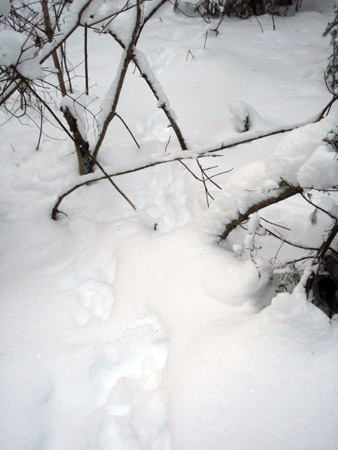 |
Now let's catch some hares. The winter is an ideal
time to snare hares. Hares leave tracks, and best of all, they are
creatures of habit. If you find reasonably fresh tracks, then
there is a pretty high probability that the same path (run) will get
re-used. I searched for runs that were naturally funnelled. A
funnel is an arrangement of sticks/rocks/material that creates an
obstacle for an animal. All else being equal, many animals (and
people) will take the path of least resistance. Why crash through
something when it is much easier to go through an inviting opening?
Some people advocate creating funnels by pushing sticks into the ground.
I figured that the less things are disturbed, the better.
This picture shows hare tracks passing right under a natural
"triangle" of sticks. |
|
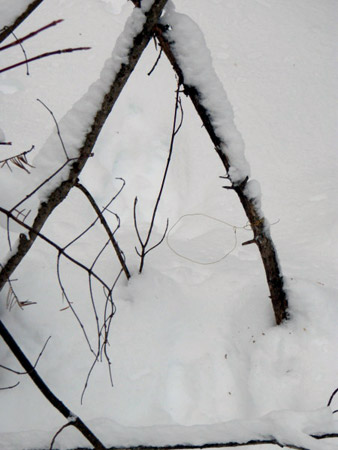 |
A close-up of
snare set in the above triangle. |
|
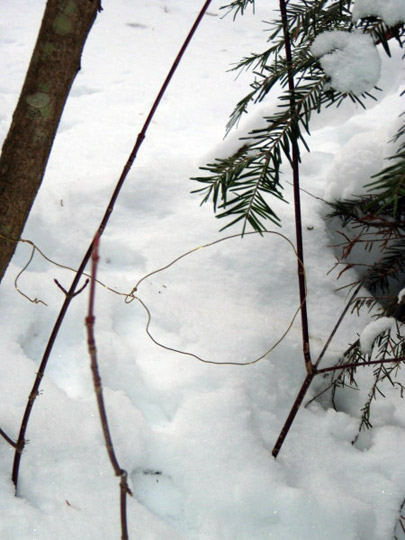 |
Another snare. One element to consider is where
the snare is set with respect to the location of the tracks. In
general I tried to set the loop close to the landing spots for the
hares. Setting the snares mid-stride doesn't seem to
be very effective for many reasons. I set my snares from 4" to 6"
above the "ground" There is lots of debate as to how high to set
the snare. Hares are probably taller than you think! If
the snow is deep, then one might set the snare a bit lower since the
hare's feet will be sinking an inch or so into the snow. The snare
loop doesn't need to be very complicated. Three of four wraps of
the wire is enough to secure the closing loop and a few wraps around a
nearby branch are all that are needed. |
|
 |
Another example of a natural funnel. This seemed
like the perfect setup. There was only one way for the hare to get
under this branch. The ground was very trampled. Clearly
this was an oft-used run. |
|
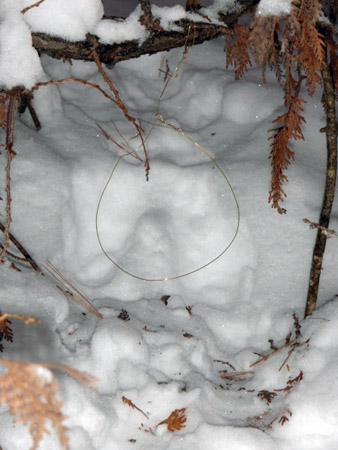 |
A close-up of the set snare. Hares are supposed to be
most active in the early morning and evening. During the
inactive times what are the hares doing? Look up
coprophagy.
Some people advocate de-scenting or camouflaging snares. One
commonly written up technique is to hold a candle flame under the wire
loop. This is supposed to get rid of any human scent and the
carbon black takes the shine off of the wire. I've never tried
this. Would it help? I don't know. Seems like a lot of extra
bother. My snares seemed to work fine without any of this. |
|
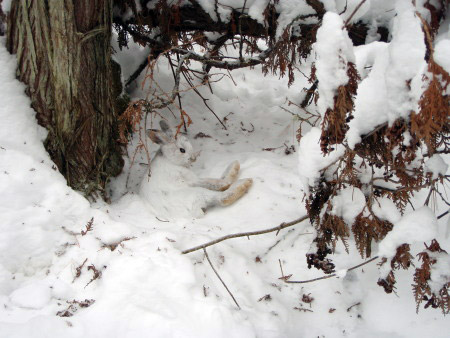 |
Success. If one is setting a lot of snares, it is a
good idea to mark them in some way. It's pretty hard to remember
exactly where one put all of those things. If one is "harvesting"
animals, then it only makes sense that one minimizes suffering and
to not waste any meat. After a few days of setting and checking
snares it's easy to forget a couple. |
|
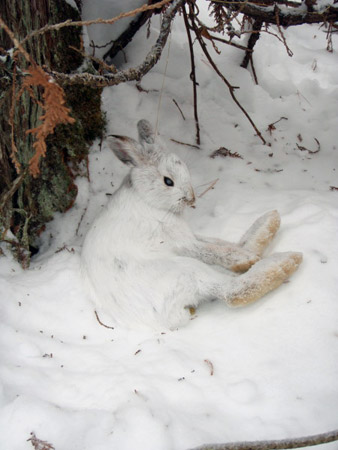 |
A close-up. I guess this is the ideal snaring
scenario. The snare wire is only around the hare's neck. No
feets/legs got caught. Judging from the amount of disturbed snow,
it seemed that it didn't take too long for this animal to pass away. |
|
 |
A close-up of the hare's feet. It is pretty
obvious why these are called "snowshoe" hares. |
|
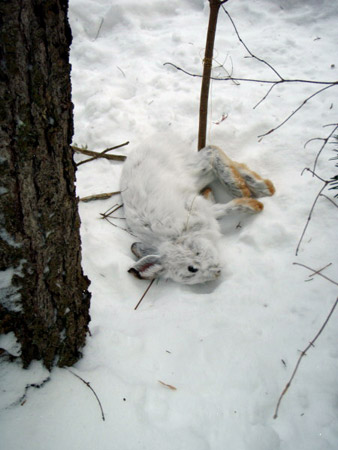 |
Another snared hare. I set this snare more or less
out in the open. There were no funnels. The snare loop was
set just in front of the "landing zone" of the hare.
I never bothered to set any snares that were more complicated than
these simple loops. It is possible that some sort of spring snare
might dispatch the animals a bit more quickly, but the flip side is that
you will disturb the run a lot more. A spring snare would also get
the animal off of the ground. On the one hand, this could be a
good thing. It gets the hare out of reach of animals such as
martins, but on the other hand, it makes the catch more visible to
birds, owls, etc. I have found snared hares with their heads gone.
And no - the head didn't come off because of the snare, it was another animal
that decided that the tastiest part of the hare was the head. On
the topic of disturbing the rabbit runs, I see two versions. One
is to leave things as pristine as possible. On the other hand, in
deep snow, I have found that the hares will follow my packed down tails.
Hey, it's easier going for them so why not? Of course one can take
advantage of this and set some snares right in the middle of your path.
A very subtle funnel can be created by having a normal width trail
narrow down with a snare set at the narrows. |
|
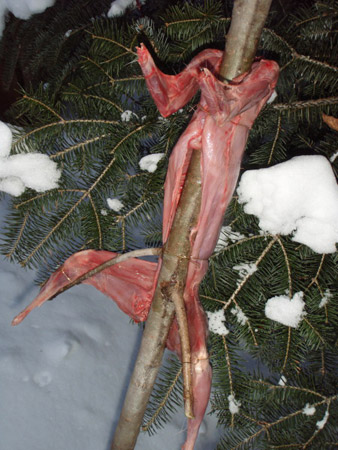 |
Ready for cooking. A few notes on cleaning hares.
Hare hides are not very thick. One can more or less tear the skin
off of a hare. No knife is required. I find that splitting the
hide around the belly and then
pulling in both directions is the fastest, cleanest was to "skin" a
hare. The hide around the legs gets pulled inside out and the
amount of hare hair floating around in the air is minimized.
If you cut your hare up into smaller pieces, take your time, the bone
structure of a rabbit is very similar to deer and presents a good
learning experience.
Rabbits/hares can harbour all sorts of diseases, parasites and other
"nasties." A common issue with rabbits/hares is Tularaemia (tularimia
and other spellings) or "rabbit fever." Most people recommend
using rubber gloves when cleaning rabbits to avoid getting infected.
There is lots of info on the web about tularaemia. Look it up and
read carefully.
I cooked this hare on a spit. Notice the stick upon which the
hare is tied. A couple of small branches were left attached.
The benefit of this is that the animal doesn't slip around the stick as
it is rotated.
|
|
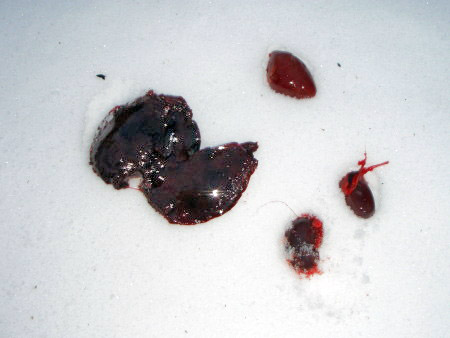 |
Here are the commonly eaten organs of the rabbit/hare.
On the left is the liver, on top is the heart, and on the lower right
are the kidneys. The liver is especially important. Even if you
don't eat the liver (it's quite good), it is common practice to have a very close look at
the liver. A sick animal often shows abnormalities on/in the
liver. A rabbit/hare with Tularimia will show spots on the liver.
Other "nasties" will also present on the liver. Most references
advocate cooking rabbit to "well done." This in theory will kill
off the "nasties."
Do a web search on rabbit diseases for more detailed info. |
|
 |
Time to start cooking... |
|
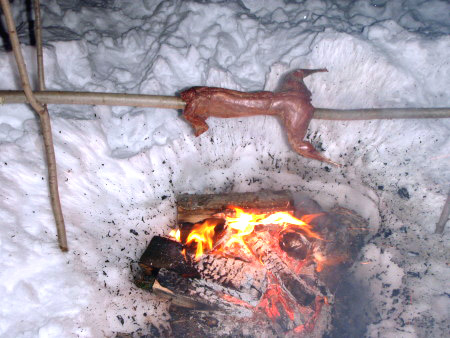 |
A view of the left side of the spit. |
|
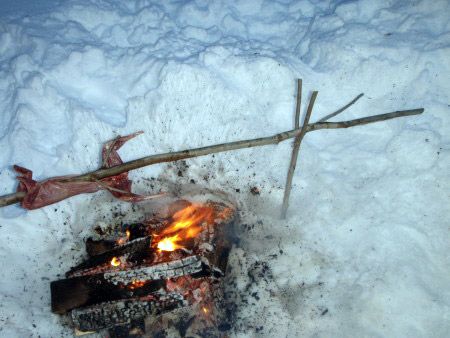 |
A view of the right side of the spit. Notice again
that a branch was left attached to the horizontal stick. This
makes it much easier to turn the spit. An open spit is wasteful of
wood and heat so I'm setting a bad example, but in this case I was more
interested in keeping myself warm, so I put myself between the fire and
a windbreak. Also, it was a nice night for a fire! |
|
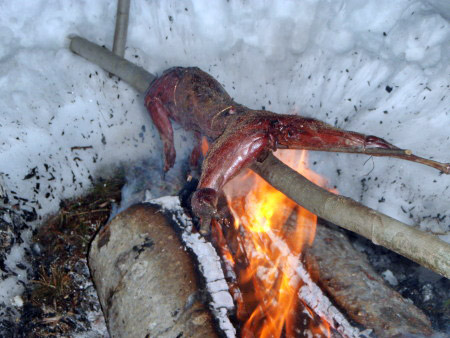 |
Done!
How long to cook? It all depends. What is the air
temperature, how high above the fire is the meat etc. The usual
way to tell is to make sure that any juices run clear. Cut into
the thickest meat when you think things should be done and check for
colour. Rabbit meat is dark, so instead of looking for just the
colour, also check for uniformity. If the colour of the meat
changes from the outside to the inside, then the inside probably isn't
cooked. |
|
 |
Since rabbits/hares have almost no fat, cooking with
"dry" heat - i.e. on spit is not the best practice. This tends to
dry out the meat and certainly doesn't do much for tenderizing it.
Alternatives are to make a stew or simply boil the meat.
Cooking in water is probably also the fastest way to guarantee that the
meat is cooked all of the way through. Another note regarding the lack of fat in rabbits/hares.
There is something called "rabbit starvation" or "fat hunger." The
theory is supposed to be that eating just protein is bad for you.
One element seems to be that the human liver is unable to convert
protein to glucose at rate sufficient to keep you alive over the long
term. Another element is that this protein to glucose process
produces ammonia as a by-product. Ammonia isn't good for you.
It seems that most of the references for rabbit starvation point to
accounts written by early explorers. I don't know how real any of
this is, so search for something a little
more modern if you are considering rabbit/hare (or very lean meat) as a
significant component of your diet. |
|
|
|
I'm sure there is a lot more to learn about this
whole process. But this should serve as a good
intro.
If you have any "constructive" comments or questions feel free to
email Rob. |
|
|
|
|